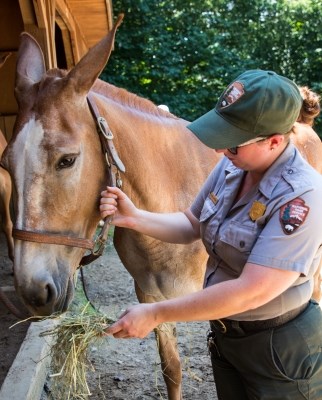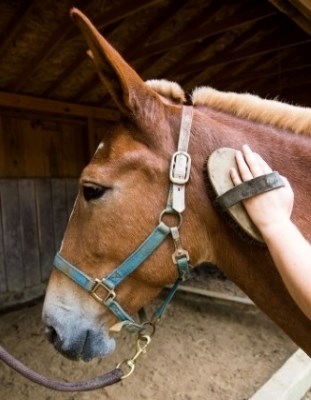|
As with most large animals, mules require regular and thorough care. During the 19th century, canal workers dedicated time to caring for the mules by feeding, grooming, and resting them. Today's park mules receive the same basic care, along with thorough, routine medical examinations and necessary medications to ensure that they live long and healthy lives. 
NPS Photo / E. Cowan FeedingFood and water are essential to a mule's longevity and wellbeing. Mules are herbivores (plant eaters) and their diet consists of grasses, grains, and shrubs. The park's team of mules are fed grain and hay according to their individual dietary needs, and they sometimes munch on fruits and vegetables for a special treat. Mules have tasebuds just like humans and can have taste and texture preferences, resulting in them liking and disliking some foods. Sleep and RestMules can sleep laying down or standing up just like horses and donkeys. Sleeping while standing allows them to run as soon as they detect danger. They typically sleep standing up but will lay down if they feel safe from predators. It is not uncommon for a team of mules to take turns standing and laying down while sleeping so that at least one mule can "stand guard" and look for predators. 
NPS Photo / E. Cowan GroomingJust like people, mules require regular grooming for their health and wellbeing. Park staff maintain a regular grooming schedule for each individual mule based on their changing needs. Just like their feeding routines, a mule's grooming regiment can change over time depending on their individual needs. Medical CareThe mules receive routine medical care as part of their overall routine. They are visited by an equine veterinarian regularly and receive annual wellness check-ups, vaccines, and nutrishion assessments. These routine exams help park staff determine if changes in feeding and grooming are needed, as well as adjustments in training or work assignments. Only mules that have a clean bill of health are assigned working tasks. |
Last updated: April 27, 2025
